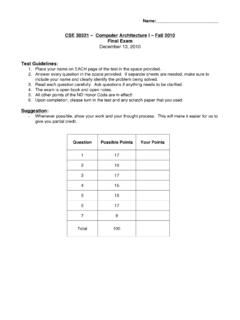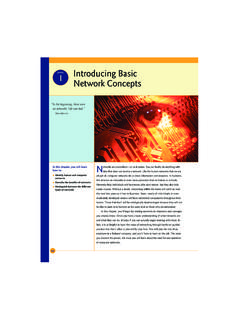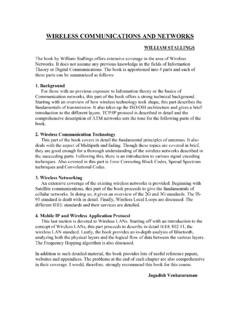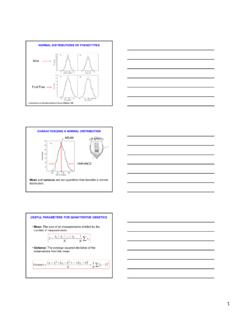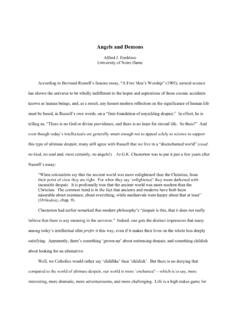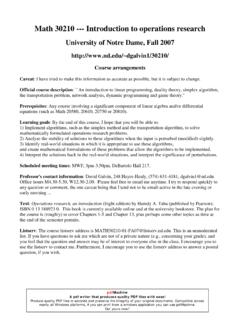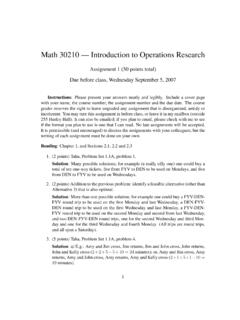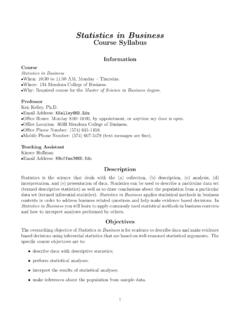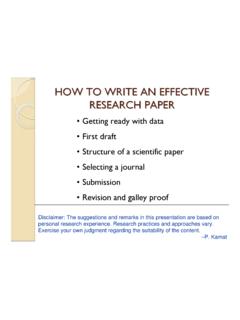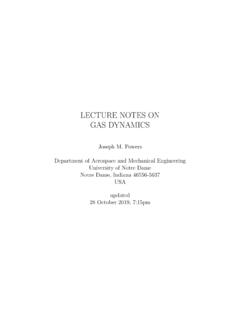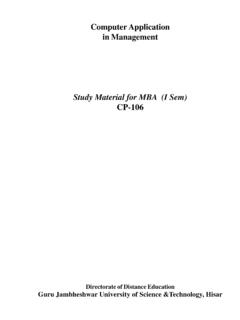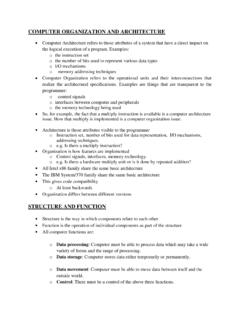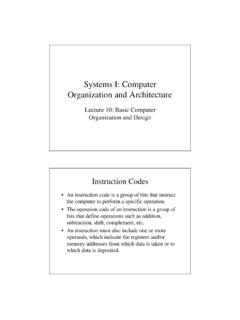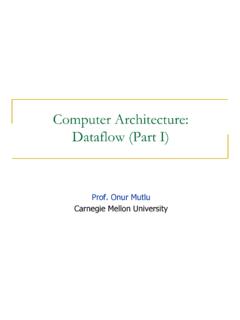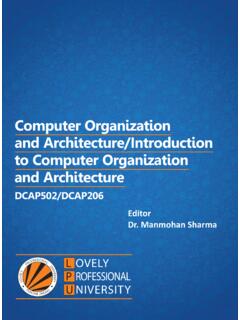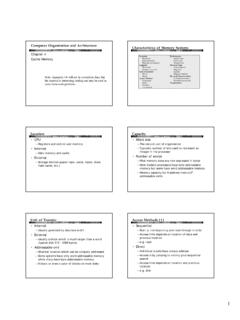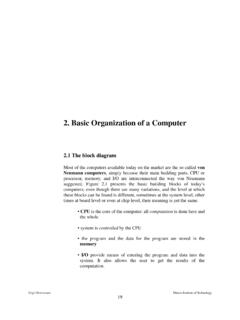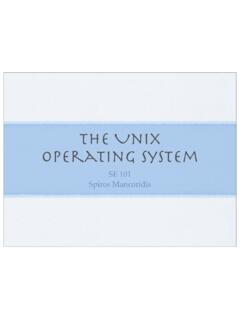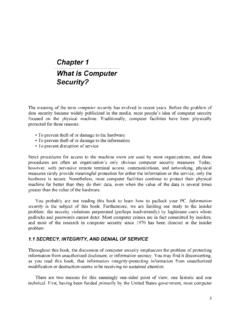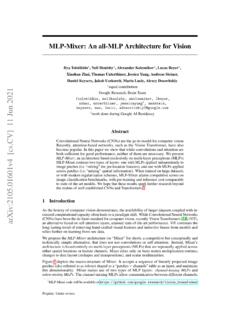Transcription of CSE 30321 – Computer Architecture I – Fall 2010 Final Exam ...
1 Name:_____ CSE 30321 Computer Architecture I fall 2010 Final Exam December 13, 2010 Test Guidelines: 1. Place your name on EACH page of the test in the space provided. 2. Answer every question in the space provided. If separate sheets are needed, make sure to include your name and clearly identify the problem being solved. 3. Read each question carefully. Ask questions if anything needs to be clarified. 4. The exam is open book and open notes. 5. All other points of the ND Honor Code are in effect! 6. Upon completion, please turn in the test and any scratch paper that you used.
2 Suggestion: - Whenever possible, show your work and your thought process. This will make it easier for us to give you partial credit. Question Possible Points Your Points 1 17 2 10 3 17 4 15 5 15 6 17 7 9 Total 100 Name:_____ Problem 1: (17 points) Question A: (5 points) A cache may be organized such that: o In one case, there are more data elements per block and fewer blocks o In another case, there are fewer elements per block but more blocks However, in both cases larger blocks but fewer of them OR shorter blocks, but more of them the cache s total capacity (amount of data storage) remains the same.
3 What are the pros and cons of each organization? Support your answer with a short example assuming that the cache is direct mapped. Your answer must fit in the box below. Solution: If block size is larger: - Con: There will be fewer blocks and hence a higher potential for conflict misses - Pro: You may achieve better performance from spatial locality due to the larger block size - Example: If you have a high degree of sequential data accesses, this makes more sense If there are fewer elements per block and more blocks: - Con: You may be more subject to compulsory misses due to the smaller block size - Pro: You may see fewer conflict misses due to more unique mappings - Example.
4 If you have more random memory accesses, this makes more sense Question B: (5 points) Assume: - A processor has a direct mapped cache - Data words are 8 bits long ( 1 byte) - Data addresses are to the word - A physical address is 20 bits long - The tag is 11 bits - Each block holds 16 bytes of data How many blocks are in this cache? Solution: Given that the physical address is 20 bits long, and the tag is 11 bits, there are 9 bits left over for the index and offset We can determine the number of bits of offset as the problem states that: - Data is word addressable and words are 8 bits long - Each block holds 16 bytes As there are 8 bits / byte, each block holds 16 words, thus 4 bits of offset are needed.
5 This means that there are 5 bits left for the index. Thus, there are 25 or 32 blocks in the cache. Name:_____ Question C: (7 points) Consider a 16-way set-associative cache - Data words are 64 bits long - Words are addressed to the half-word - The cache holds 2 Mbytes of data - Each block holds 16 data words - Physical addresses are 64 bits long How many bits of tag, index, and offset are needed to support references to this cache? Solution: We can calculate the number of bits for the offset first: - There are 16 data words per block which implies that at least 4 bits are needed - Because data is addressable to the word, an additional bit of offset is needed - Thus, the offset is 5 bits To calculate the index, we need to use the information given regarding the total capacity of the cache: - 2 MB is equal to 221 total bytes.
6 - We can use this information to determine the total number of blocks in the o 221 bytes x (1 block / 16 words) x (1 word / 64 bits) x (8 bits / 1 byte) = 214 blocks - Now, there are 16 (or 24) blocks / set o Therefore there are 214 blocks x (1 set / 24 blocks) = 210 or 1024 sets - Thus, 10 bits of index are needed Finally, the remaining bits form the tag: - 64 5 10 = 49 - Thus, there are 49 bits of tag To summarize: Tag: 49 bits; Index: 10 bits; Offset: 5 bits Name:_____ Problem 2: (10 points) Question A: (5 points) The average memory access time for a microprocessor with 1 level of cache is clock cycles - If data is present and valid in the cache, it can be found in 1 clock cycle - If data is not found in the cache, 80 clock cycles are needed to get it from off-chip memory Designers are trying to improve the average memory access time to obtain a 65% improvement in average memory access time, and are considering adding a 2nd level of cache on-chip.
7 - This second level of cache could be accessed in 6 clock cycles - The addition of this cache does not affect the first level cache s access patterns or hit times - Off-chip accesses would still require 80 additional CCs. To obtain the desired speedup, how often must data be found in the 2nd level cache? Solution: We must first determine the miss rate of the L1 cache to use in the revised AMAT formula: AMAT = Hit Time + Miss Rate x Miss Penalty = 1 + Miss Rate x 80 Miss Rate = Next, we can calculate the target AMAT .. AMAT with L2: Speedup = Time (old) / Time (new) = / Time (new) Time (new) = clock cycles We can then again use the AMAT formula to solve for highest acceptable miss rate in L2: = 1 + x (6 + (Miss RateL2)(80)) Solving for Miss RateL2 suggests that the highest possible miss rate is ~ Thus, as the hit rate is (1 Miss Rate), the L2 hit rate must be ~75%.
8 Name:_____ Question B: (5 points) Assume that the base CPI for a pipelined datapath on a single core system is 1. - Note that this does NOT include the overhead associated with cache misses!!! Profiles of a benchmark suite that was run on this single core chip with an L1 cache suggest that for every 10,000,000 accesses to the cache, there are 308,752 L1 cache misses. - If data is found in the cache, it can be accessed in 1 clock cycle, and there are no pipe stalls - If data is not found in the cache, it can be accessed in 10 clock cycles Now, consider a multi-core chip system where each core has an equivalent L1 cache.
9 - All cores references a common, centralized, shared memory - Potential conflicts to shared data are resolved by snooping and an MSI coherency protocol Benchmark profiling obtained by running the same benchmark suite on the multi-core system suggests that, on average, there are now 452,977 misses per 10,000,000 accesses. - If data is found in a cache, it can still be accessed in 1 clock cycle - On average, 14 cycles are now required to satisfy an L1 cache miss What must the CPI of the multi-core system be for it to be worthwhile to abandon the single core approach?
10 Solution: We first need to calculate the CPI of the single core system and incorporate the overhead of cache misses: CPI = 1 + (308,753 / 10,000,000)(10) = We need to better this number with the multi-core approach. Thus: > X + (452,977 / 10,000,000)(14) > X + > X Thus, the CPI must be less than reasonable as execution will proceed in parallel. Name:_____ Problem 3: (17 points) Question A: (6 points) Below, you are provided with a snapshot of a 4 entry, fully associative TLB and a page table.
